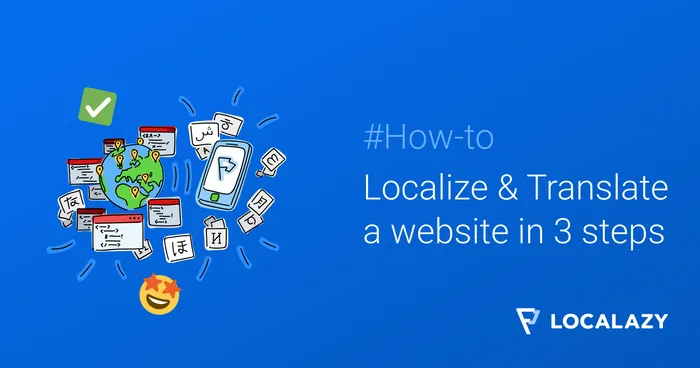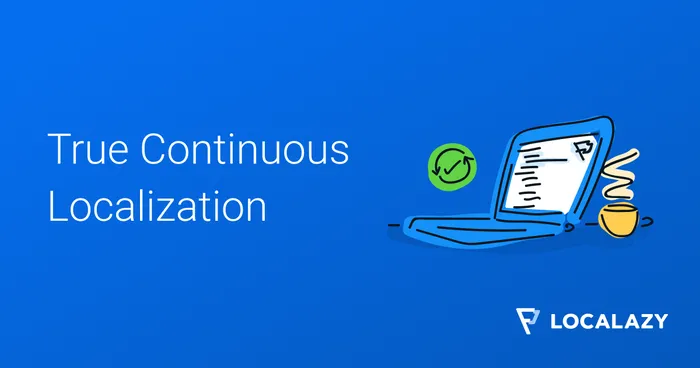There’s no growth without pain.
In localization, this pain often equals high costs, long hours of research, and large teams of experts. In-house data and know-how are the only effective way forward, so if you lack these key ingredients, your company won’t be able to grow.
This assumption often leads to lost opportunities.
Localization isn’t only for big businesses with large budgets. Your small or medium-sized business can grow globally, too. And you don’t need to hire expensive consultants to enter new regions in style.
All you need is a change of perspective. And a different set of tools.
One such tool is a large language model.
👀 What's the cheapest way to localize your SaaS? 🔗
Localization for SaaS companies typically costs between $10,000 and $50,000 for initial entry into a single language. Ongoing annual maintenance is pricey too, ranging between 15 and 25% of that cost each year.
This isn’t money thrown down the drain. Companies that invest in localization are more likely to grow revenue, with 96% reporting a positive return from their efforts and 65% reporting a ROI of 3x or greater as a result. If done smartly, localization costs less than deciding not to localize. How is that possible? We explained it in this article on best practices to allocate a budget for localization – whether it’s big or small. The key conclusion is: localization is not optional.
But how to benefit from localization when your budget is tight?

Small and mid-sized SaaS companies often struggle to find resources for such an investment. Market data, competitor analysis, linguistic insights – every single step multiplies the costs.
This is where AI may come in handy. It makes localization planning more accessible for smaller brands. Using tools such as ChatGPT or Claude, you can easily conduct market research, validate assumptions, or spot market trends.
No more guesswork. No more delays. No more excuses.
🔦 When does AI localization research make sense? 🔗
AI-powered research can be useful in these two scenarios:
- You’re localizing for the first time and need to make smart moves fast.
- You’re already present on the global market, but want to scale without overloading/expanding your team.
Let’s have a closer look at both situations.
The Starter 🔗
You’ve built a product that’s working in your home market. Web traffic is growing, and sales figures are climbing. You know that localizing your product and marketing could lead to more growth, but you’re now wondering:
- How do I choose which countries to expand to first?
- What’s the best go-to-market strategy for startups?
- How can I define my go-to-market strategy?
You don’t have a localization team, and hiring localization strategists is out of the question.
With a few smart prompts, AI can:
- Suggest languages for localization based on your current user engagement.
- Build an internationalization roadmap tailored to your existing setup.
- Help you compare potential markets using publicly available data.
The Scaler 🔗
You’ve experimented with localization. Maybe you’ve translated your app into a few languages or hired freelance translators for your blog. Perhaps you also have multiple users across Europe and Asia, but your growth is slow.
You’re wondering:
- Is it a good idea to localize everything for more impact?
- Which markets deserve significant investment?
- Should we use ChatGPT for market research?
With the right AI-powered prompts, you can:
- Audit your existing localization efforts.
- Prioritize regions based on user visits and revenue.
- Build a localization ROI model to support strategic decisions.
Whether you’re just starting or scaling up, AI can give you enough data to build your roadmap and make the right decisions.

⬇️ What we’ll cover 🔗
In this guide, we’ll show you how to use ChatGPT and similar LLMs to support key parts of your go-to-market localization strategy.
You’ll get ready-to-use prompt templates for:
- 🗺️ Choosing your first or next localization markets
- 🪜 Mapping a lightweight internationalization plan
- 💰 Estimating and tracking localization ROI
Each prompt is designed for two scenarios: companies just starting out and those scaling into new regions.
Disclaimer: Always review and adapt prompts to your business context. Don’t share sensitive data. Use anonymized or high-level info when feeding AI tools.
With this cleared out, let’s look into the nitty-gritty.
🗺️ How to craft your localization strategy roadmap with AI 🔗
1. Language selection 🔗
Choosing the right languages is a tough enterprise when you don’t have solid data to lean on. Guesswork might be costly, but you can use this prompt to craft effective go-to-market strategies.
Act as a localization strategist helping a small SaaS company identify the most strategic languages for their first localization effort.
Here’s the company background:
- Product: [brief description of your product or service]
- Current market: [main market, e.g., UK, Germany]
- Existing users outside the core market: [any known user traffic or signups by region or language, if available]
- Ideal customer profile: [who your main users are: include industry, job titles, pain points]
- Known limitations: [budget, team size, tech stack limitations]
Based on this context, which 3–5 languages would be the most strategic to start with, and why? Include expected benefits and potential challenges.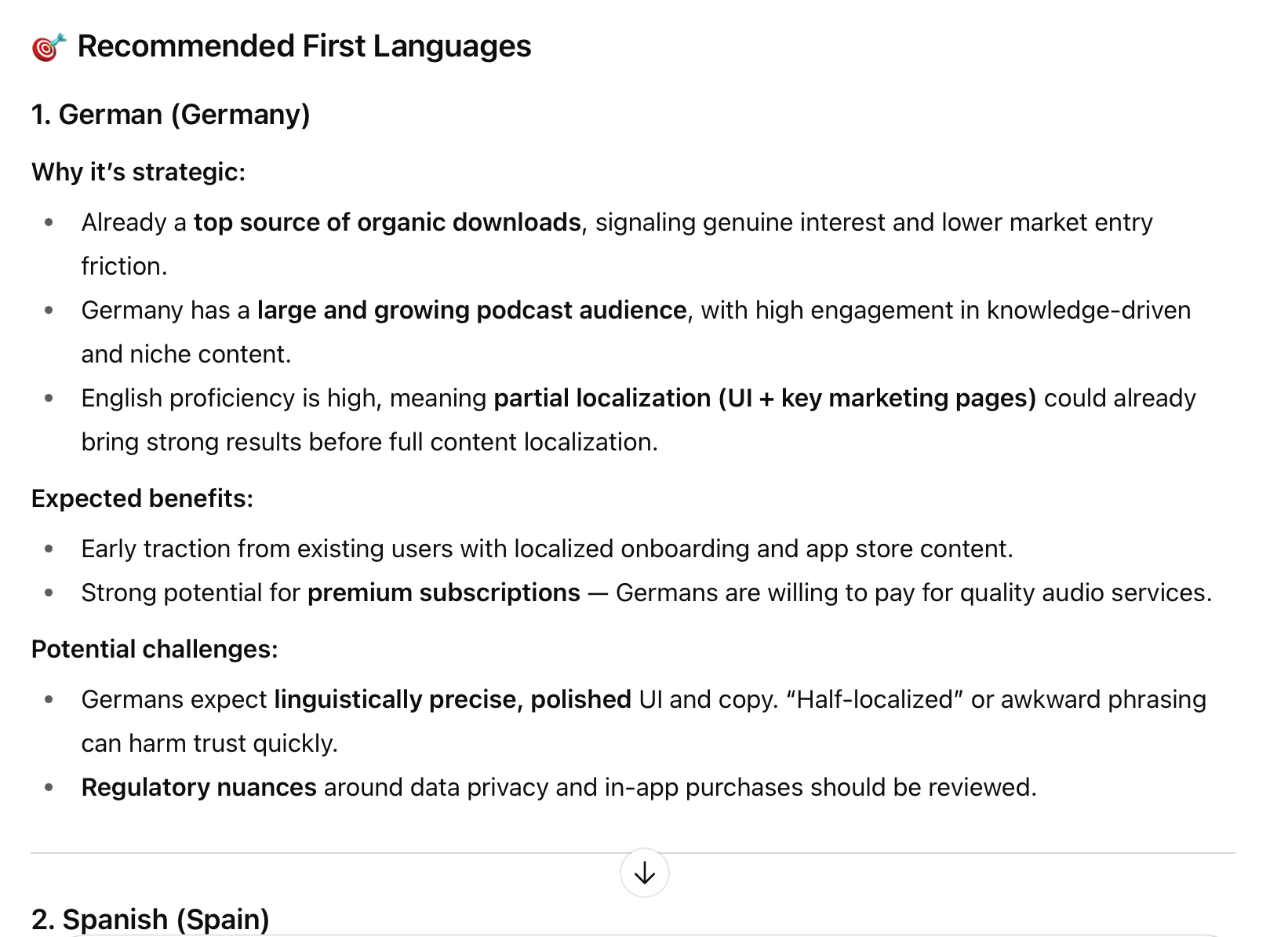
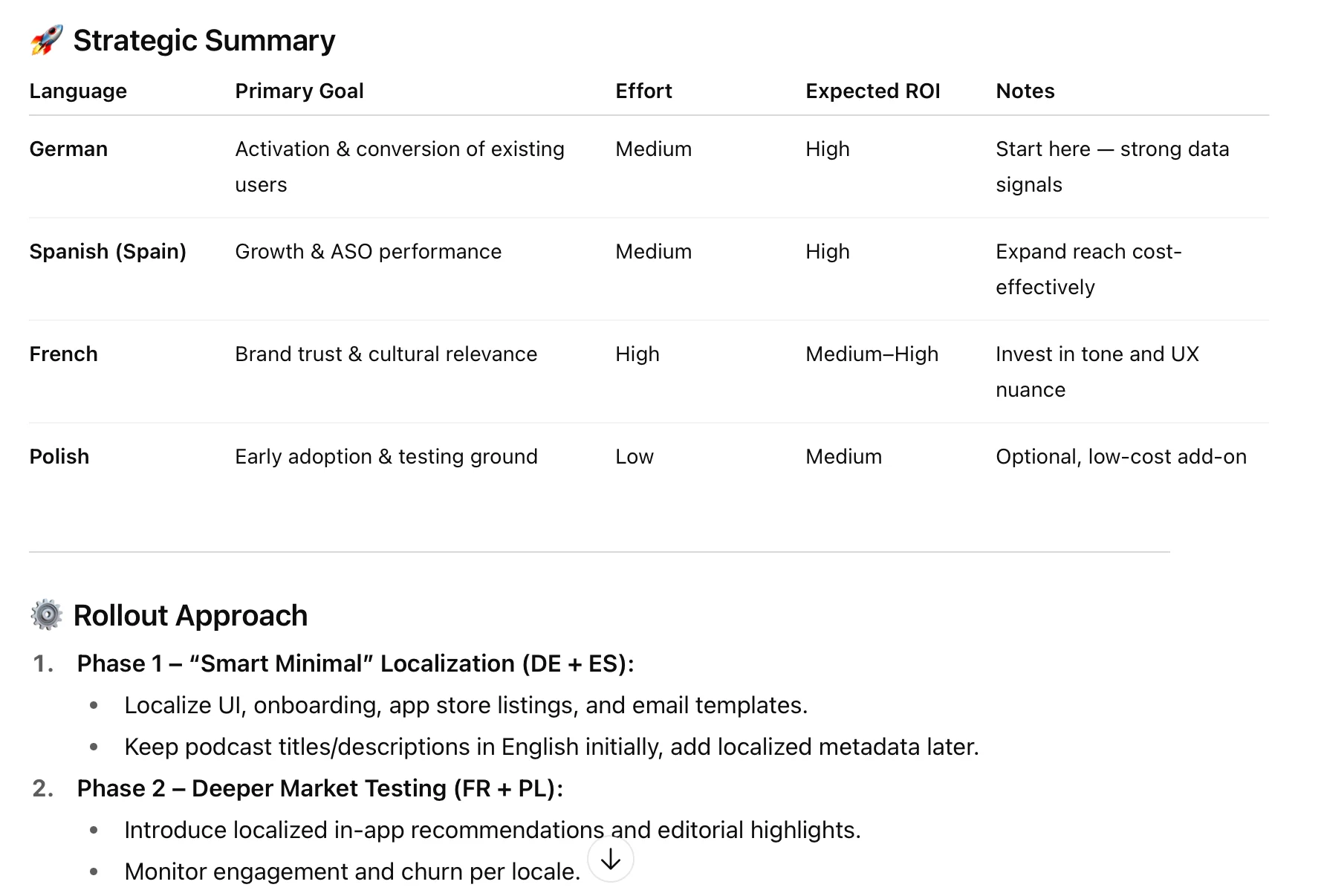
Act as a senior localization strategist supporting a SaaS company with an existing international presence. Help us evaluate and prioritize the next 3–5 languages to localize into based on our current presence and growth goals.
Here’s the company context:
- Product: [brief description of your product or service]
- Existing localized languages: [list]
- Regions or countries we currently serve: [list]
- Web traffic by region/language: [if available]
- Conversion and churn rates by region/language: [if available]
- Support ticket language trends or user requests: [if any]
- Ideal customer profile: [industry, buyer role, usage patterns]
- Strategic goals: [e.g., deepen market penetration, enter new regions]
- Constraints: [e.g., limited resources, need for quick wins, tech limitations]
Based on this input, suggest which 3–5 new languages would offer the highest potential impact. For each language, explain:
- Why it's a good fit based on our user base and growth goals
- Potential challenges or hidden costs
Also note any “nice-to-have” languages we could consider later, and markets we might want to avoid for now.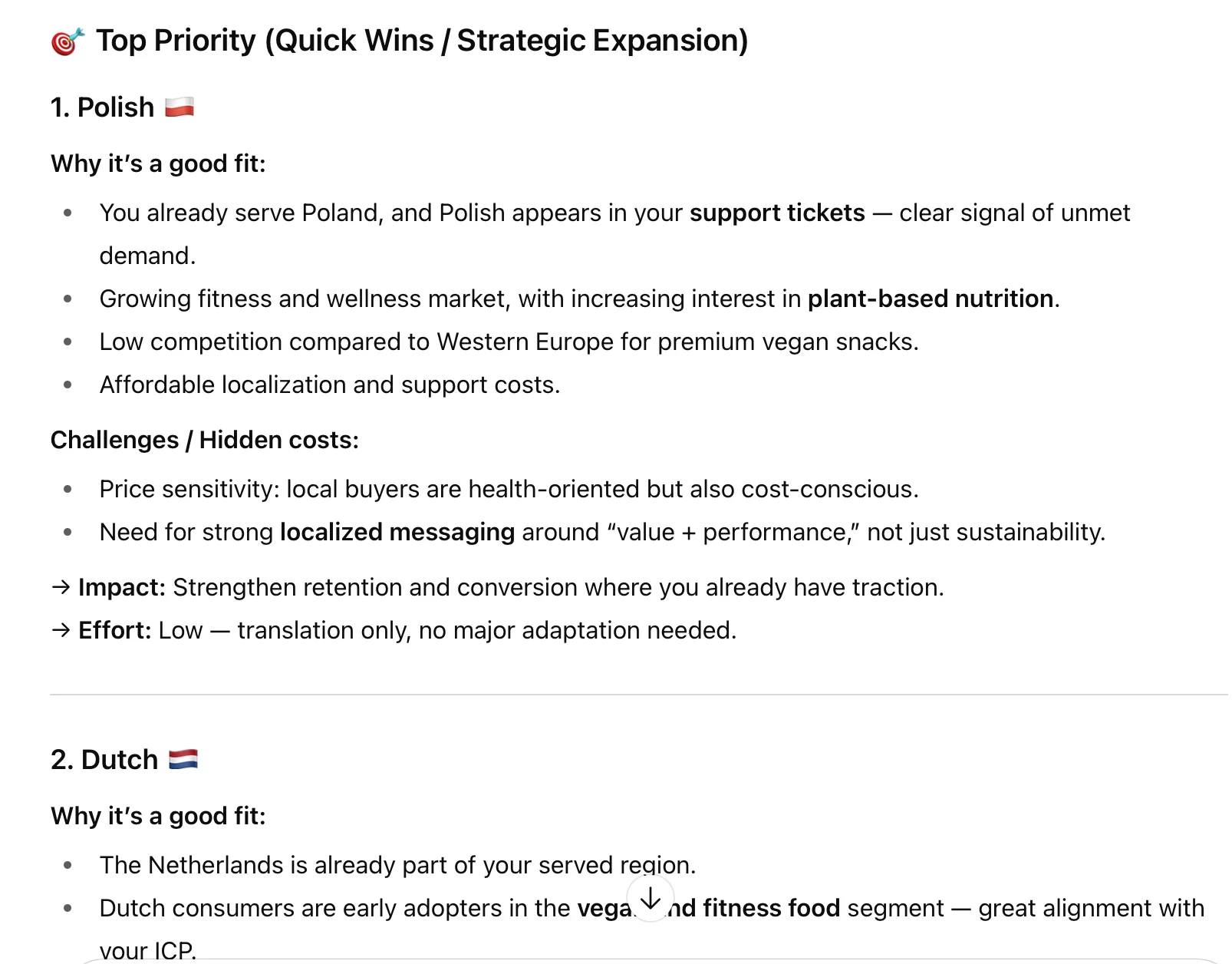
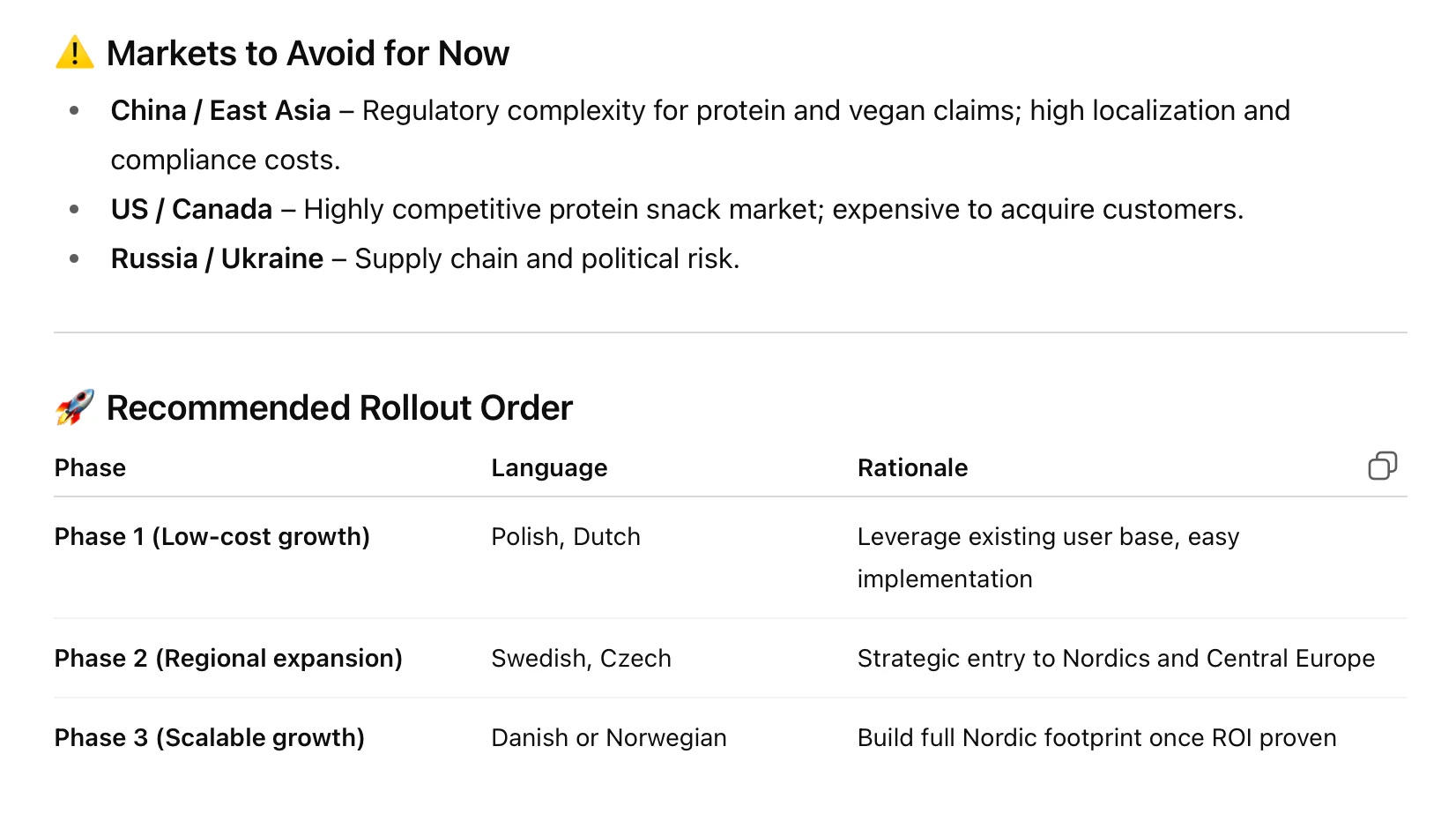
Before evaluating which languages to localize into, it’s essential to define your global ambitions and identify where you can realistically compete. In this guide on choosing the right language, we break down four key pillars to consider: economic viability, cultural alignment, strategic fit, and regulatory complexity. By using these pillars, you can make smarter market entry decisions.
96% of companies report a positive ROI from localization efforts. These efforts start with choosing the right language. Now, with the AI prompts for marketing strategy presented above, you’ll be able to take the first steps towards more revenue.
2. Internationalization roadmap 🔗
Once the language puzzle is solved, it’s time to move to the next phase. With the prompt discussed below, you can create an internationalization plan that will prepare your content for localization.
Act as a localization and internationalization strategist guiding a small SaaS company through its first internationalization effort. We want a phased, startup-friendly roadmap that helps us prepare our product and content for localization without disrupting our core development.
Here’s the company context:
- Product type and key features: [brief description]
- Current tech stack: [e.g., CMS, Localazy, etc.]
- Team structure: [e.g., small engineering team, no dedicated localization manager]
- Budget or resource limits: [if any]
- Target markets and languages: [initial picks or regions of interest]
- Timeline goals: [e.g., ready for launch in 3–6 months]
Based on this, outline an internationalization roadmap that includes:
- Key technical tasks (e.g., extracting translatable strings, handling date formats, multilingual UI support)
- Content preparation steps (e.g., rewriting hardcoded content, structuring metadata for translation)
- Suggested tooling or automation
- Realistic phases with estimated timelines
- Any “quick wins” we can implement early
Flag any common pitfalls we should watch out for.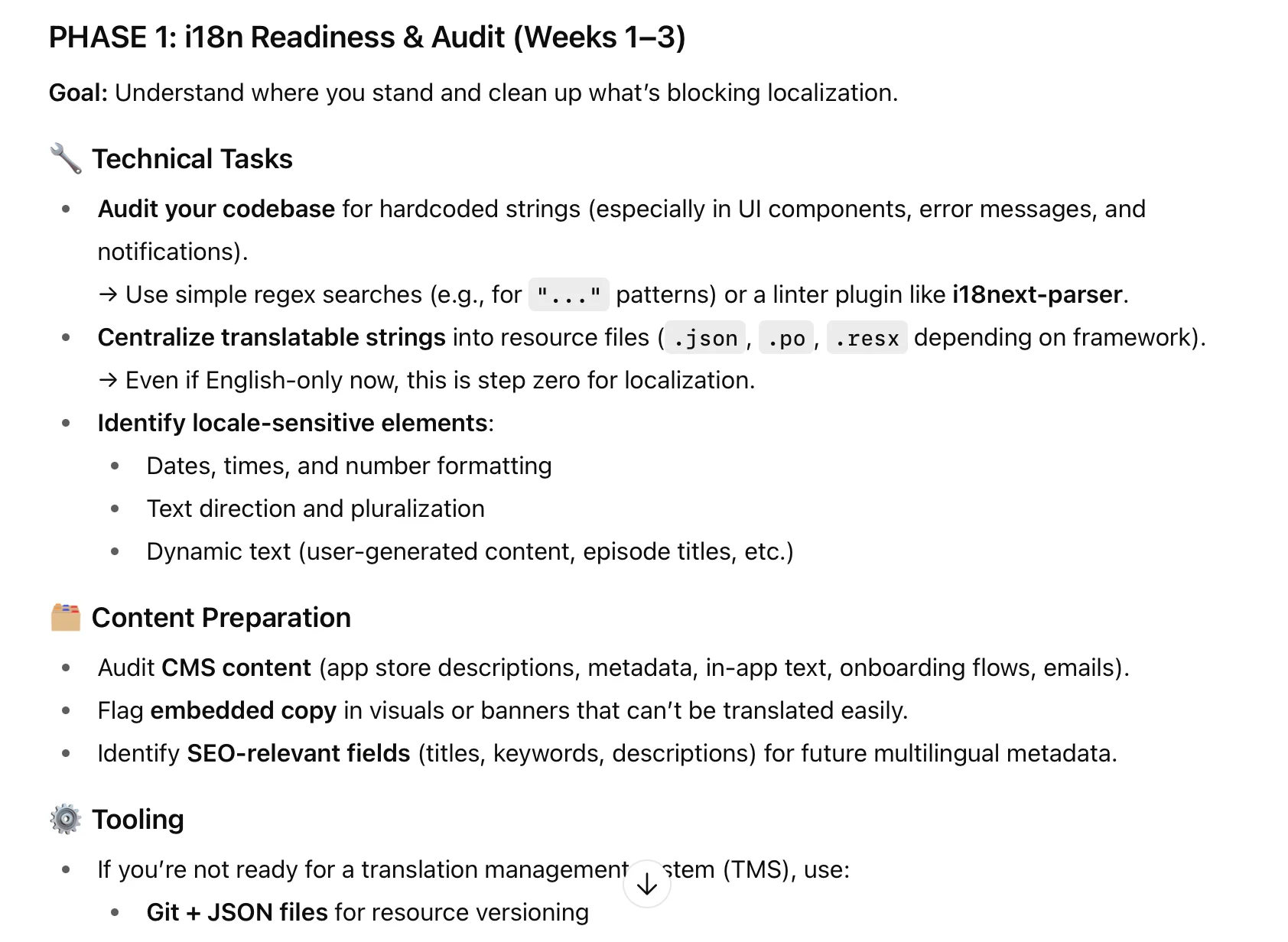
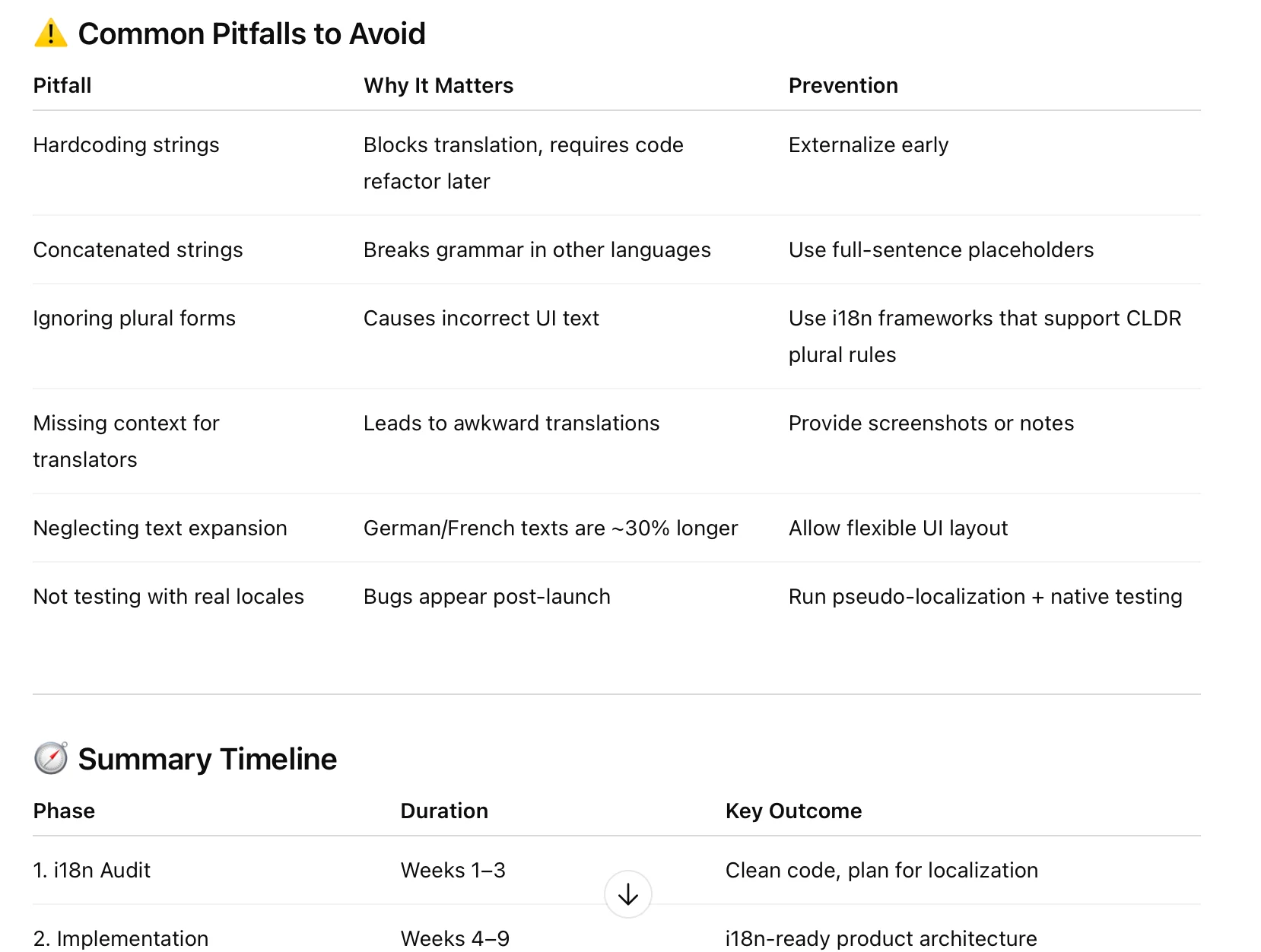
Act as a senior internationalization strategist advising a SaaS company that has already localized into several languages but lacks a structured, scalable internationalization process. Help us design a roadmap that prepares our product, content systems, and teams to expand into new markets.
Here’s our current situation:
- Product overview: [short description]
- Current languages and markets: [list]
- Tech stack and frameworks: [e.g., headless CMS, Localazy]
- Known internationalization gaps or pain points: [e.g., hardcoded UI strings, inconsistent translation workflows]
- Team setup: [e.g., engineering, marketing]
- Growth goals: [e.g., enter 3 new regions in the next 12 months]
- Constraints: [e.g., no full-time internationalization lead, limited engineering time]
Based on this context, build an internationalization roadmap that includes:
- Technical priorities for scalable internationalization (e.g., locale management, automation)
- Workflow and tooling improvements (e.g., TMS integration, automated QA)
- Governance and roles (e.g., who owns what, central vs local input)
- Sequencing by impact and feasibility
- Milestones over the next 3–12 months
Highlight common scaling traps to avoid.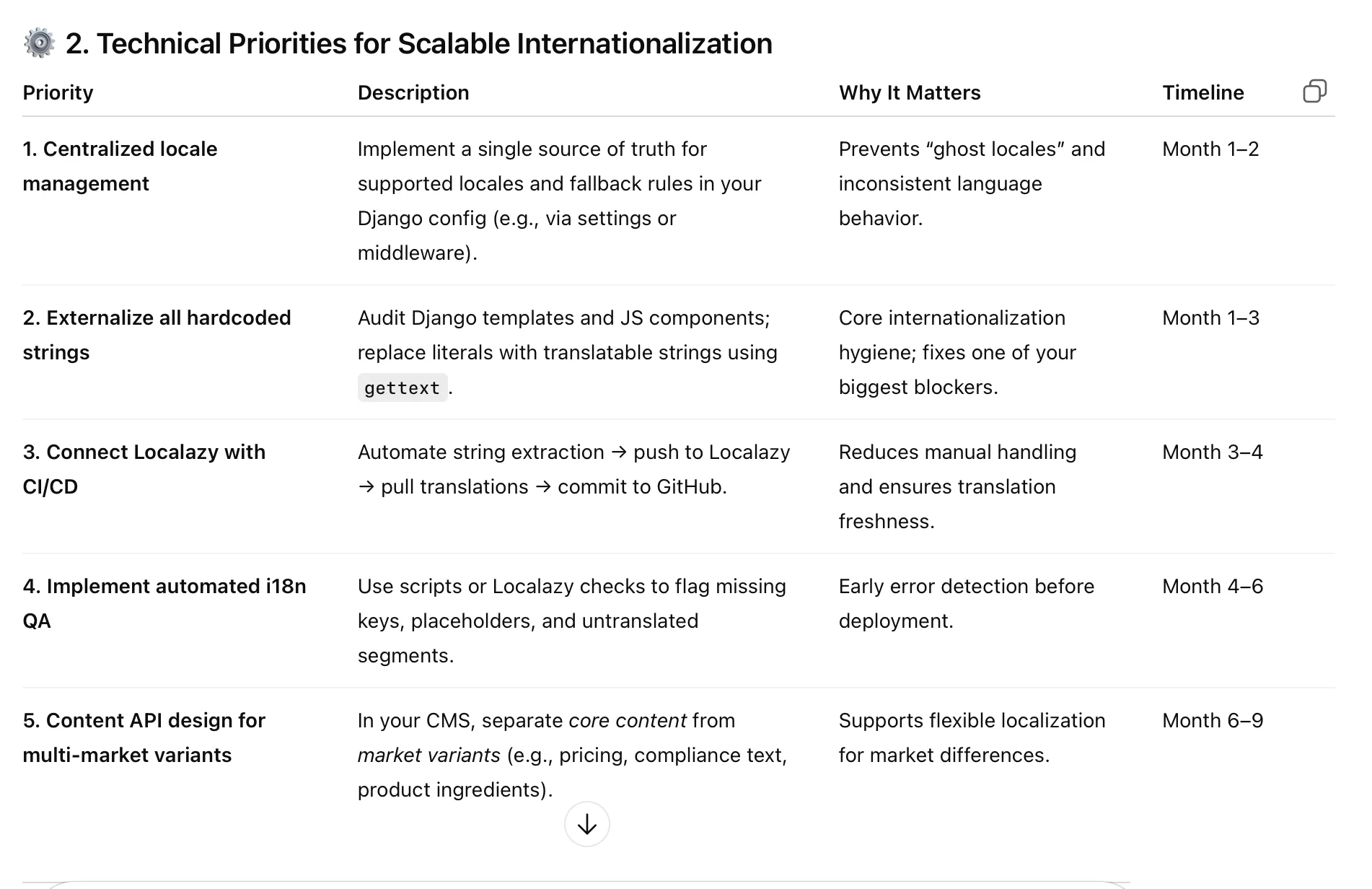
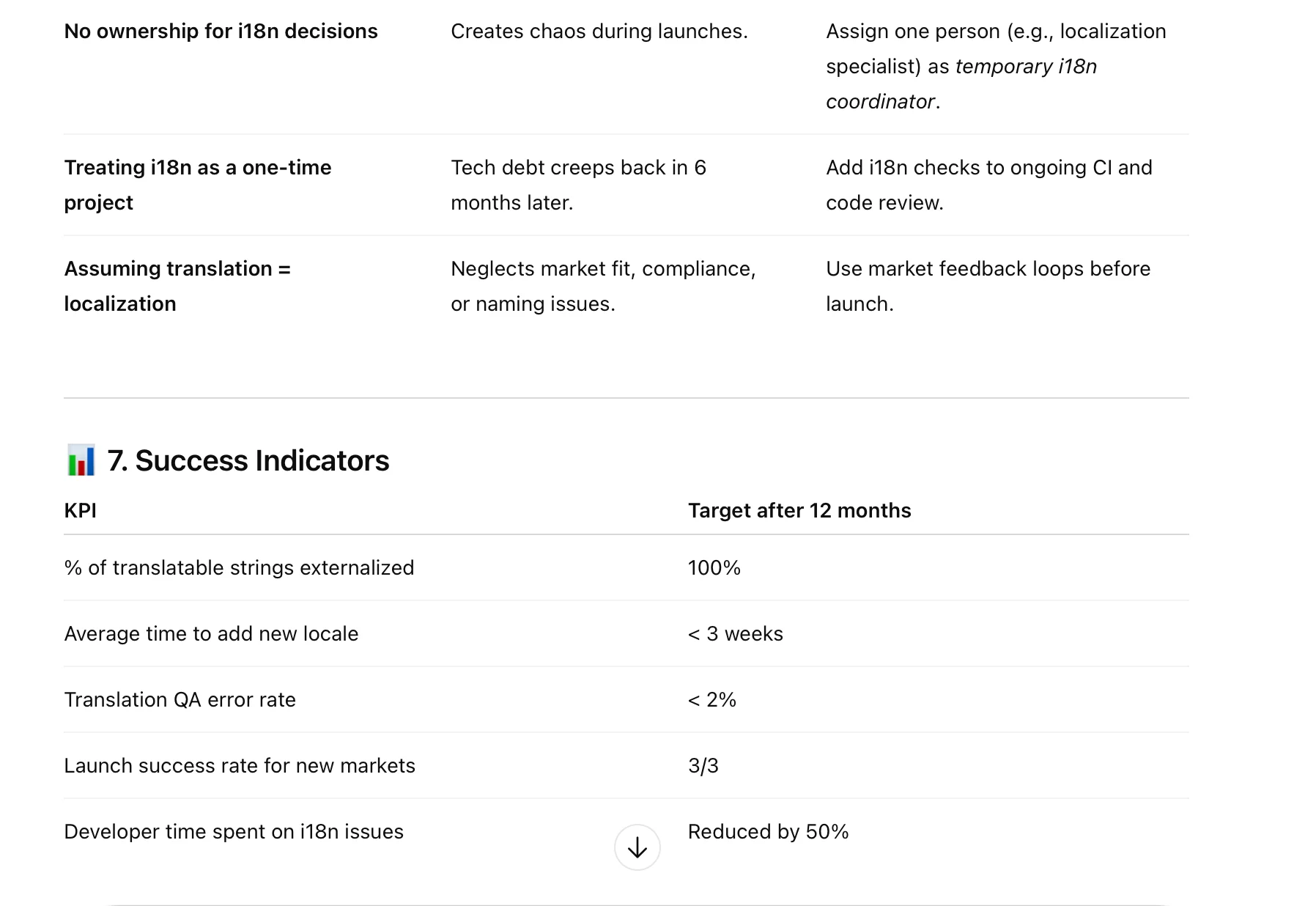
There’s no localization without internationalization. So, don’t cut corners by jumping straight into translating your content. It has to be market-ready first. If you’re in doubt as to what internationalization involves, have a look at our short explanation here.
Effective internationalization can save companies around 30-50% in preparation and localization costs, while significantly reducing time-to-market. With the prompts presented above, you’ll be on the right track to achieve these savings as well.
3. Localization ROI tracker 🔗
Your i18n and localization efforts might be worthless if you don’t know how to track your gains. But there’s a prompt for that, too. This is how you can create a localization ROI tracker tailored to your company.
Act as a SaaS localization strategist helping a small company define a simple, actionable way to track the return on their first localization investments.
Here’s the company context:
- Product type: [brief description]
- Initial localization plan: [languages or regions to be localized, content]
- Key goals: [e.g., increase signups, grow in non-English markets]
- Data available: [e.g., traffic by region, conversion rates]
- Current tools: [e.g., HubSpot, custom dashboards]
Based on this, create a basic ROI tracking framework that includes:
- What to track before and after localization (e.g., traffic, signups, conversion)
- A few simple KPIs that reflect product and content performance across regions
- How to attribute improvements to localization efforts
- How often to review the data and what to look for
Prioritize clarity and startup-readiness. The framework should be easy to implement using existing tools and help us make smarter localization decisions over time.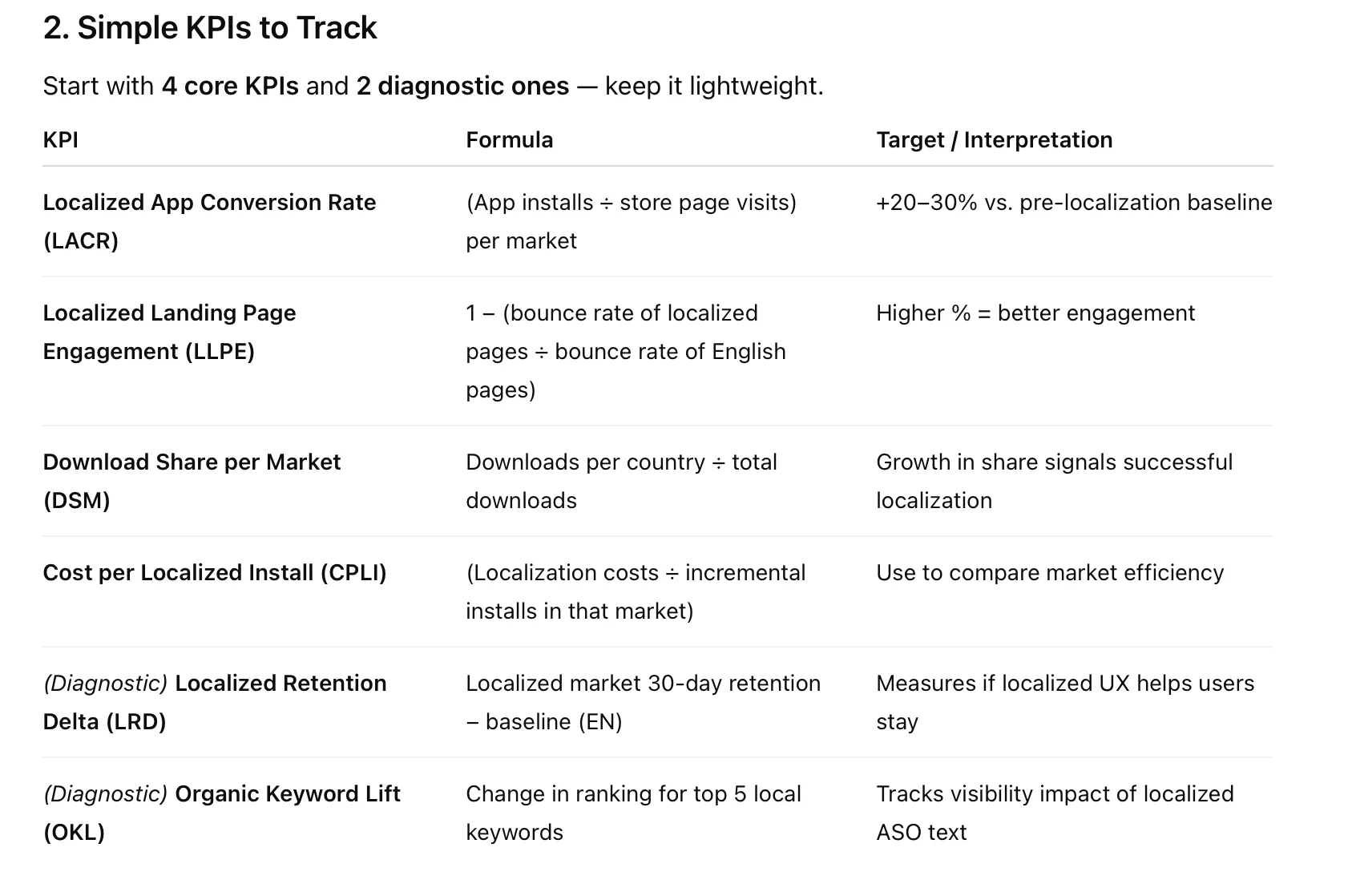
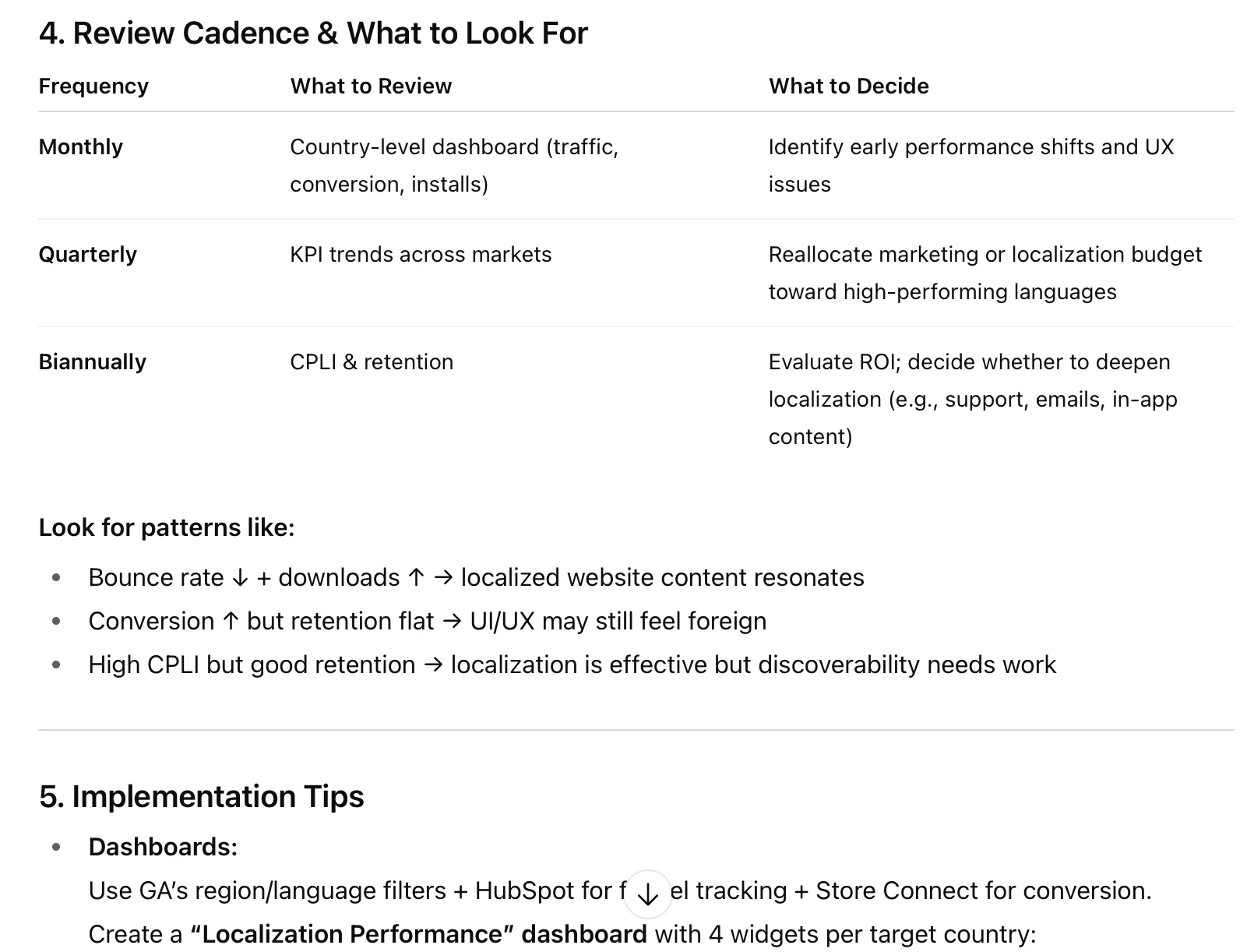
Act as a senior localization strategist advising a SaaS company that has already localized into several markets. We need a structured but practical way to track the ROI of our localization efforts, so we can optimize budgets and prioritize high-performing regions.
Here’s our company context:
- Product type: [brief description]
- Current localized languages: [list]
- Primary growth goals: [e.g., increase paid user conversion]
- Available data: [e.g., app downloads by region, engagement metrics]
- Current tools: [e.g., HubSpot, Google Analytics]
- Known gaps or challenges: [e.g., inconsistent tagging]
Based on this input, create a localization ROI tracking framework that includes:
- Metrics to track across the funnel (awareness, acquisition, activation, retention, revenue)
- Which KPIs to monitor for each language/region
- How to compare localized vs non-localized markets
- Suggestions for data visualization and reporting
- How often to review performance and adjust strategy
The framework should be actionable, scalable, and team-friendly. Also, note any common pitfalls to avoid.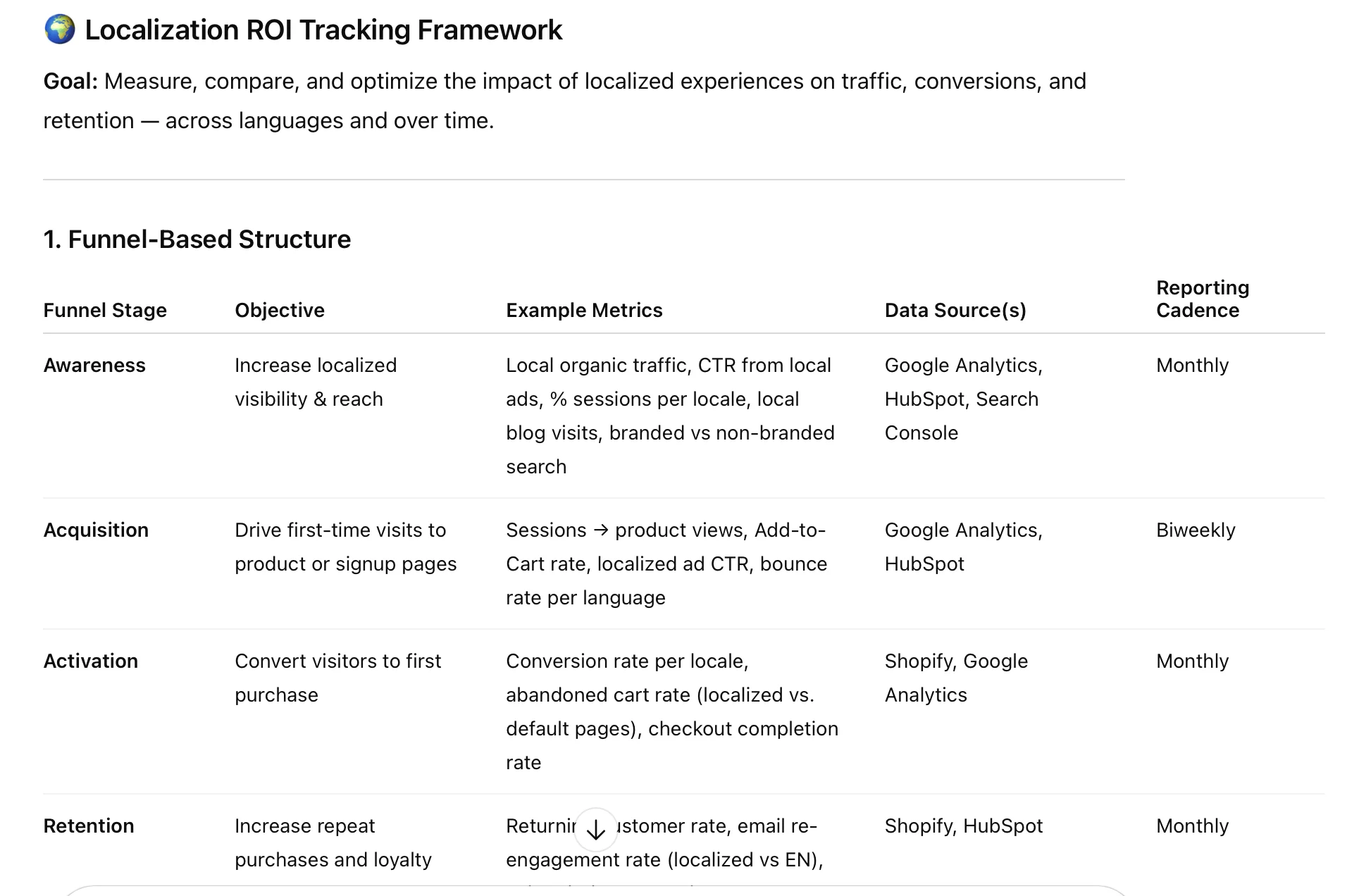
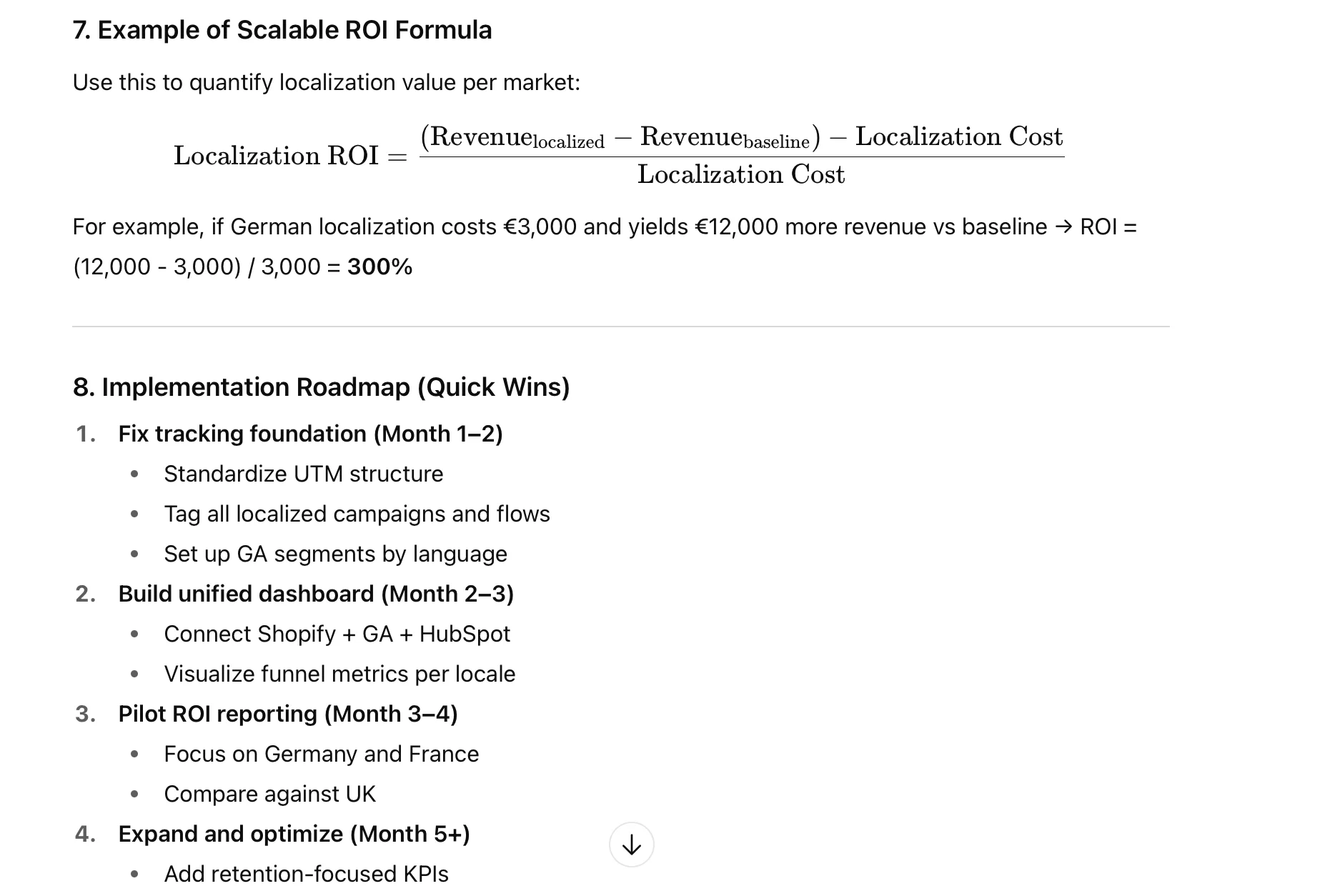
The formula for your localization ROI might depend on your KPIs, but in essence, it boils down to:
We explained it in more detail in this guide to measuring your localization ROI: Costs, benefits and KPIs.
Companies using AI for performance and investment ROI tracking save over 20 hours per employee each month, which helps to reduce operational costs by 30%.
Now, with the prompt above, you can join the ranks of these smart brands as well.
🔎 How to effectively use AI prompts for a localization strategy? 🔗
The prompts we’ve just discussed are not set in stone. You can play around with them and customize them to your business needs. It won’t hurt to take a step further and add relevant real-world data, too.
Here’s a short overview of how to enrich your prompts and generate more tailored results:
1. User research and feedback 🔗
Adding relevant data from customer reviews, support tickets, or customer surveys will allow the AI model to provide more precise suggestions on content prioritization, new markets, and languages. The outputs will match the actual user behavior.
2. Channel performance by market 🔗
Some channels outperform others in specific regions, and spotting these early can reveal valuable market identification trends. This kind of data helps you decide which content to localize first based on where engagement is already happening. Even if your SaaS company is active in just one market for now, you can enrich your prompt by sharing which channels you currently use or plan to test when entering new markets.
3. Competitor benchmark 🔗
You don’t need a deep market analysis, but a quick scan of 2-3 competitors’ websites, apps, or marketing content can be a good source of invaluable insights.
Your competitors have already made decisions about language, content, or channels that you can learn from. By using effective prompts for market research, you can spot market gaps, identify competitive differentiators, or come up with strategies that align or deliberately contrast with the market norm.

💬 The final prompts, ready to use 🔗
We’ve reached the end of our prompting journey. But before you jump into experimenting with these free prompts for GTM strategy, here’s a clear overview and a checklist to make sure you know where to start.
📋 AI-powered localization strategy checklist 🔗
Even the best prompts for GTM strategy can backfire if you act without a plan.
Make sure to follow these steps to stay on track:
☑ Define your goal: Are you launching for the first time or expanding existing localization?
☑ Gather key business context: Product type, ICP, traffic sources, known constraints.
☑ Collect available data: Traffic, conversion rates, support tickets, customer feedback.
☑ Analyze your competitors: Identify which markets, languages, and content types they localize.
☑ Run the language selection prompt: Prioritize target languages based on data and goals.
☑ Create an internationalization roadmap: Map out tech, content, and timeline phases.
☑ Define your localization KPIs: Use the ROI tracker prompt to measure what matters.
☑ Feed your prompts rich context: Include all the inputs above to boost AI accuracy.
☑ Review AI-generated insights: Validate outputs with your team before implementation.
Finally, don’t forget to choose your tools wisely. If you’re ready to localize your content and enter new markets, use tools such as Localazy and Localazy AI to put your AI-powered localization strategy into action. When in doubt, you can always ask your preferred LLM about the best course of action in localization using Localazy, or contact us directly.

🤔 FAQ: Using AI prompts for your localization strategy 🔗
1. Can I trust AI-generated insights for strategic decisions?
Act with caution. AI is a powerful research assistant, not a decision-maker. The prompts in this guide are designed to show useful patterns and perspectives. Always validate outputs with real data and your team’s feedback before putting AI suggestions into action.
2. What if I don’t have all the data the prompts ask for?
That’s not a problem at all. Even partial context can improve the output quality. Start with what you have and refine later as you collect more data over time.
3. Is it safe to include business data in my prompts?
Not really. Avoid sharing sensitive or personally identifiable information. Summarize or anonymize wherever possible to protect your data while still guiding the AI effectively.



